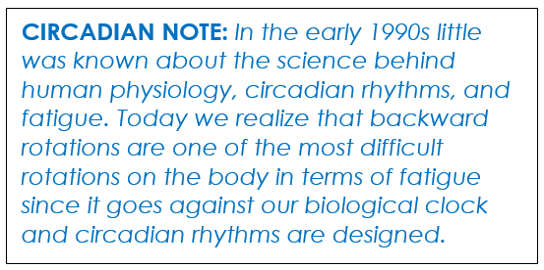Explore the history of shiftwork scheduling! Discover how 8-hour and 12-hour shifts evolved and learn which might work best for your productivity and work-life balance.
In the vast world of shift scheduling, there has long been a debate about which is better: 8-hour or 12-hour shifts. Have you ever wondered how we got here?
Shift work as we know it started in the late 1800s, thanks to two important events:
-
Thomas Edison refined the light bulb,
-
The second Industrial Revolution.
Both events combined radically changed how we work. Up until this point, we were primarily an agricultural-based society along with some local craftsmen providing goods for their communities. Folks got up with the sun and slept at night. The addition of the commercially available light bulb meant businesses could run all day and night. Existing industries like textile mills expanded their operations to run overnight, and new ones, such as petroleum refining, steel manufacturing, and electrical power, emerged.
Welcome to the 24/7 shift work world that we know today.
First, there were 12-hour shifts:
One of the first 24/7 shift work shift schedules in the United States dates back to the late 1800s. This schedule involved employees working twenty-seven 12-hour shifts in a row, rotating every 2 weeks between day and night shifts, with 1 day off every 4-week cycle. To operationalize this 4-week rotation, employees worked one 24-hour shift when transitioning from the day to night shift. Two weeks later workers received one day off when transitioning from night to day shifts. Companies used 2-crews and employees worked an average of 84 hours per week.
Labor unions promote the 8-hour shift: 
In the early 1900s when labor unions formed, schedules moved from 12-hour to 8-hour shifts. Companies converted to a 3-crew system with employees rotating between the day, evening, and night shifts every 7 days. No one was scheduled for a day off. In addition, the shifts were designed to have a “Backward Rotation” that transitioned from nights to evenings and evenings to day shifts. This provided workers with a shorter work week (an average of 56 hours per week), at least 8 hours off between every shift rotation, and prevented double shifts (16 hours) when transitioning from nights to days.
Overtime makes an entrance during the Great Depression:
With historic numbers of people out of work during the Great Depression in the 1930s, the Fair Labor Standards Act was passed, requiring companies to pay overtime for hours worked over 40 hours in a pay week. The Act, designed to get more people into the workforce, forced companies to provide their workers with scheduled days off to avoid paying too much “federal overtime”. In response, companies converted their 3-crew schedules with no days off into the 4-crew systems with scheduled days off that we are accustomed to today.
Circadian science introduces forward rotations:
In the ensuing decades as our knowledge of human physiology, circadian rhythms, and fatigue evolved, people started using a forward rotation from day to evening to night shift instead of the backward rotation. This was easier to do with 4-crew systems because the double shifts caused by a 3-crew system were now prevented. Furthermore, to respond to employee preferences for more days and weekends off, some companies began to combine 8 & 12-hour shifts while others converted to a complete 12-hour schedule (with no 8-hour shifts).
In some ways, it appears that shift work shift scheduling may have come a full circle and has returned to its roots of the 12-hour workday. The reality is that there is no perfect shift schedule. For some companies, 8-hour shifts work best, while the 12-hour shift meets operational criteria and employee preferences for others. Either way, forward-thinking companies are now investing time and resources when determining the optimal shift schedule for their site.
Want More Information About 8-Hour and 12-Hour Shifts?
Download our free resources to dive deeper into the benefits and challenges of different shift schedules.
-
White Paper: Pros and Cons of 8-Hour Shifts
-
White Paper: Pros and Cons of 12-Hour Shifts
-
White Paper: Biocompatible Shift Scheduling
Considering Alternative Shift Schedules?
If you are considering alternative schedule options for your operation, keep in mind that the best schedule for any group of shift work employees is a site-specific solution that appropriately balances management, employees, and health and safety criteria. If you are unsure how to do this, CIRCADIAN’s proven methodology has been successfully helping clients for the past four decades to identify the optimal schedule for their operation.
Our Shift Schedule Optimization Process is a positive and participatory schedule selection process that provides a win-win for both management and employees.
For over 40 years, CIRCADIAN® has been at the forefront of enhancing 24/7 workforce performance and safety solutions, guiding organizations in effectively defining their fatigue risk tolerance. Our deep-rooted expertise in shift schedule optimization and fatigue risk management positions us as your ideal partner in this journey.
Reach out for a complimentary 15-minute consultation and learn more about the steps involved in defining your organization’s threshold for fatigue risk!
- Call us: 781-439-6300
- Email:
This email address is being protected from spambots. You need JavaScript enabled to view it.
FAQ
Working 12-hour shifts can be challenging for health, particularly if not managed well. Prolonged shifts may lead to fatigue, sleep deprivation, and stress. However, with proper shiftwork management, including regular breaks, healthy eating, and adequate sleep, many employees can maintain a healthy balance. Our shift scheduling services can help create a balanced shift schedule tailored to your team's needs, ensuring well-being and productivity.
A typical 12-hour shift schedule involves working either from 7 AM to 7 PM or from 7 PM to 7 AM. Employees usually work fewer days per week, such as 3 or 4 days, allowing for longer periods of time off. If you need assistance in designing an efficient and effective shiftwork schedule, we can provide customized solutions that fit your operational requirements and employee preferences.
A 4-5-5-4 shift schedule is a rotating pattern often used in industries requiring 24/7 coverage. Employees work 4 days, followed by 5 days off, then work 5 days, followed by 4 days off. This schedule provides a balance of work and rest periods, enhancing productivity and minimizing fatigue. Our team can help you implement a 4-5-5-4 schedule that meets your specific operational needs and supports your employees' well-being.
In a 12-hour shiftwork schedule, breaks are essential for maintaining health and productivity. Typically, employees should have at least two 30-minute breaks, in addition to shorter breaks throughout the shift. We can assist in structuring your shift schedule to ensure adequate breaks are provided, keeping your workforce alert and effective throughout their shifts.
Labor unions in the early 1900s advocated for shorter workdays and better working conditions, which led to the adoption of 8-hour shifts. This change was aimed at reducing worker fatigue, improving safety, and ensuring fair labor practices in shift schedules.



